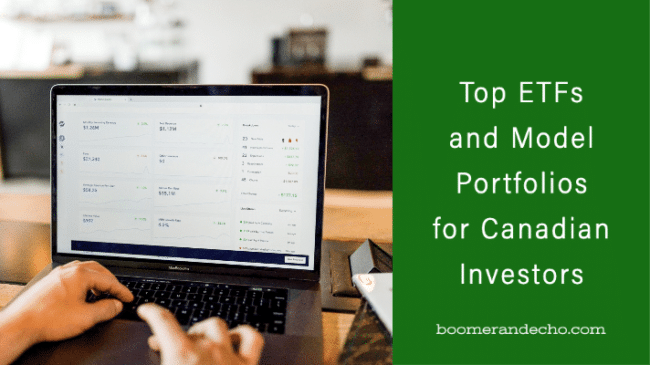Top ETFs and Model Portfolios for Canadian Investors

The investing landscape has certainly evolved for the better over the past two decades. Gone are the days when the only way to invest was to work with an expensive broker or mutual fund salesperson. Self-directed investing platforms, robo-advisors, and all-in-one ETFs have democratized investing – making it cheap and accessible for investors to build a portfolio at any age and stage.
Today, just as mutual funds dominated the investing scene in the 1990s, exchange-traded funds (ETFs) are exploding in popularity as investors flock to low cost passive investing products. The challenge for investors is to separate the wheat from the chaff. Indeed, according to the Canadian ETF Association (CETFA), there are now more than 1,100 ETFs offered by 40 ETF providers.
In this article, I’ll break out the top ETFs for Canadian investors to help you avoid analysis paralysis and make an informed decision about which ETFs to hold in your portfolio.
Then I’ll take it one step further and show you one simple portfolio to get started with a self-directed index investing portfolio, and one more complicated version to help investors with larger portfolios save on fees.
First, let’s sort out the top ETFs from that list of 1,100+ funds. I’m going to stick with ETFs from the three largest ETF providers in Canada (stats from Jan 2023):
- BlackRock Canada: 143 ETFs and $104.9B in assets under management
- BMO Asset Management: 152 ETFs and $95.7B in assets under management
- Vanguard Canada: 37 ETFs and $59.7B in assets under management
I’m also going to screen out any ETFs that are actively managed or that focus on a specific sector (I’m looking at you, BetaPro Crude Oil 2x Daily Bull ETF).
Instead, we’re looking for ETFs that track as broad of an index as possible to give investors the ultimate diversification of global stocks and bonds. I’ve narrowed down the list to the top 20 ETFs on the market.
Canadian Equity ETFs
Each of these two ETFs offer exposure to approximately 200 of Canada’s top small, medium, and large companies for an ultra-low fee.
- Vanguard FTSE Canada All Cap Index ETF (VCN)
- iShares Core S&P/TSX Capped Composite Index ETF (XIC)
U.S. Equity ETFs
Each of these two ETFs offer exposure to the entire U.S. stock market by tracking the CRSP US Total Market Index.
- iShares Core S&P US Total Market Index ETF (XUU)
- Vanguard U.S. Total Market Index ETF (VUN)
International and Emerging Market ETFs
Vanguard’s VIU and iShares’ XEF offer exposure to thousands of stocks in the developed world outside of North America (Europe and the Pacific), while VEE and XEC, respectively, give investors exposure to thousands of stocks from emerging markets around the globe.
- Vanguard FTSE Developed All Cap ex North America Index ETF (VIU)
- Vanguard FTSE Emerging Markets All Cap Index ETF (VEE)
- iShares Core MSCI EAFE IMI Index ETF (XEF)
- iShares Core MSCI Emerging Markets IMI Index ETF (XEC)
Global Equity ETFs
Investors can avoid holding individual ETFs for U.S. equity, international equity, and emerging markets by choosing one of these two global equity ETFs (All World, ex Canada).
- iShares Core MSCI All Country World ex Canada Index ETF (XAW)
- Vanguard FTSE Global All Cap ex Canada Index ETF (VXC)
Bond ETFs
These popular Canadian bond ETFs give investors exposure to the broad universe of Canadian government and corporate bonds.
- BMO Aggregate Bond Index ETF (ZAG)
- Vanguard Canadian Aggregate Bond Index ETF (VAB)
All-in-One ETFs
Vanguard, iShares, and BMO all offer all-in-one balanced ETFs that come in several different flavours depending on your risk tolerance. These one-decision ETFs circumvent the need to hold multiple ETFs.
Vanguard
- Vanguard All-Equity ETF Portfolio (VEQT)
- Vanguard Growth ETF Portfolio (VGRO)
- Vanguard Balanced ETF Portfolio (VBAL)
iShares
- iShares Core Equity ETF Portfolio (XEQT)
- iShares Core Growth ETF Portfolio (XGRO)
- iShares Core Balanced ETF Portfolio (XBAL)
BMO
- BMO All Equity ETF (ZEQT)
- BMO Balanced ETF (ZBAL)
- BMO Growth ETF (ZGRO)
Model ETF Portfolios (Putting It All Together)
I’ve pulled out the top 20 ETFs, but that’s still a lot for investors to sort through when deciding which ones to use for their own portfolio. Now I’m going to break things down even further by showing you an ideal model ETF portfolio depending on the size of your account(s).
Along the way you may need to make trade-offs that include simple versus complex, low cost versus even lower cost, and automatic monitoring and rebalancing versus a more hands-on approach to portfolio construction.
The need for these trade-offs becomes more apparent as your portfolio grows over time.
One-Fund ETF Portfolio vs. 3-Fund ETF Portfolio
First, we’re going to look at an example of a young investor with an initial $10,000 to invest. We’ll assume the appropriate asset mix for this investor is a portfolio with 80 percent equities and 20 percent bonds.
Keep the process as simple as possible when you’re building an ETF portfolio. That means you should likely choose one of the asset allocation ETFs (one ETF solutions), such as iShares’ XGRO or Vanguard’s VGRO.
One-Fund ETF Portfolio ($10,000)
| Ticker | MER | % Allocation | $ Allocation | $ Fee |
| XGRO | 0.21% | 100% | $10,000 | |
| Total | 0.21% | 100% | $10,000 | $21 |
The trade-off for a slightly higher fee is the simplicity of these products. They automatically adjust your allocation behind the scenes, so you don’t have to monitor or rebalance on your own.
Select a self-directed investing platform, fund your account, and then purchase the single ETF. It’s that easy.
I’d recommend choosing Questrade, which offers free ETF purchases, or Wealthsimple Trade, the mobile-only investing platform that offers zero-commission ETF trades.
Since you’ll likely be adding new money regularly, and likely in smaller amounts, a one-ETF solution is ideal to avoid having to tinker and rebalance your portfolio with every contribution.
As you can see by the model portfolio breakdowns for the more complex portfolios, you’d be tweaking each individual ETFs amount with every purchase to try and stay true to your original asset mix.
Three-Fund ETF Portfolio ($10,000)
| Ticker | % MER | % Allocation | $ Allocation | $ Fee |
| VCN | 0.06% | 25% | $2,500 | |
| XAW | 0.22% | 55% | $5,500 | |
| VAB | 0.09% | 20% | $2,000 | |
| Total | 0.15% | 100% | $10,000 | $15 |
That’s why I highly recommend a one-ETF solution for new investors who plan to invest a small amount to start, and want to add small, frequent contributions with every paycheque.
Adding Complexity to Save on Fees
When you’re first starting your investing journey it makes sense to value simplicity over fees. That’s because in the early stages of investing your savings rate and contributions will have much more of an impact than fees.
But when your portfolio grows to the six-figure range, perhaps even around $200,000, these extra costs can certainly add up. At this point it can make sense to add some complexity, such as unbundling a one-ETF solution in favour of adding some lower fee U.S. listed ETFs.
U.S.-listed ETFs come with lower MERs and less foreign withholding taxes. But they require you to invest using U.S. currency. Since it can be expensive to convert currency, investors perform a manoeuvre known as Norbert’s Gambit to convert CAD to USD and vice-versa.
The good news is that if and when you’re ready to do this, a discount brokerage platform like Questrade can support USD and the Norbert’s Gambit move.
Let’s now look at model ETF portfolios for an investor with a $200,000 portfolio.
One-Fund ETF Portfolio ($200,000)
| Ticker | MER | % Allocation | $ Allocation | $ Fee |
| XGRO | 0.21% | 100% | $200,000 | |
| Total | 0.21% | 100% | $200,000 | $420 |
The one-ETF solution is still incredibly cheap compared to any mutual fund or actively managed portfolio.
But let’s show how low our costs can get when we dissect the portfolio into three ETFs.
Three-Fund ETF Portfolio ($200,000)
| Ticker | MER | % Allocation | $ Allocation | $ Fee |
| VCN | 0.06% | 25% | $50,000 | |
| XAW | 0.22% | 55% | $110,000 | |
| VAB | 0.09% | 20% | $40,000 | |
| Total | 0.15% | 100% | $200,000 | $308 |
With a $200,000 portfolio you’ll save $112 per year by using the three-ETF model portfolio.
Let’s take things one-step further with a five-ETF solution courtesy of PWL Capital’s Justin Bender and his “ridiculous” model ETF portfolio.
Lowest Fee ETF Solution (RRSPs – $200,000)
| Ticker | MER | % Allocation | $ Allocation | $ Fee |
| VAB | 0.09% | 20% | $40,000 | |
| VCN | 0.06% | 24% | $48,000 | |
| VTI | 0.03% | 31.83% | $63,660 | |
| VIU | 0.22% | 18.00% | $36,000 | |
| VWO | 0.10% | 6.17% | $12,340 | |
| Total | 0.09% | 100% | $200,000 | $180 |
With this low-fee solution our investor would save $240 per year by unbundling the one-ETF solution in favour of this five-ETF portfolio.
- Vanguard Canadian Aggregate Bond Index ETF
- Vanguard FTSE Canada All Cap Index ETF
- Vanguard Total Stock Market ETF (U.S.-listed)
- Vanguard FTSE Developed All Cap ex North America Index ETF
- Vanguard FTSE Emerging Markets ETF (U.S.-listed)
Two of the ETFs are U.S.-listed, meaning you’ll need a USD account and USD currency to purchase the funds. As mentioned, you’ll also need to perform the currency conversion move called Norbert’s Gambit to exchange CAD and USD and avoid currency conversion fees.
The extra tinkering, monitoring, and rebalancing may not be worth it for some investors (me included), but as your portfolio grows the cost savings may become too tempting to ignore.
Final thoughts
When you’re starting out with $5,000 or $10,000 to invest it doesn’t make a ton of sense to slice-and-dice your portfolio into a handful of different ETFs.
A one-ticket ETF is all you need at this stage while you build up your investment portfolio. Later on, as your portfolio grows and the fees start to creep up, then consider a more complex portfolio that can help you save on MER and foreign withholding taxes.
Related: Need help setting up your own DIY investing portfolio? Check out my DIY Investing Made Easy video series.
I know that 1,000+ ETFs can be overwhelming, and you may not know where to start. Hopefully this guide can help you avoid analysis paralysis so you can start investing confidently in ETFs.
Decide on a model portfolio and an asset mix that’s suitable for your situation. Use a self-directed investing platform like Questrade or Wealthsimple Trade to save on transactional costs. Put your money to work regularly by setting up automatic contributions.
And, finally, stick to your investing plan through good times and bad. Passive investing through index ETFs is designed to deliver market returns, minus a small fee. That means your investment portfolio will go up and down with the direction of the market.
Over the long term, that risk has paid off handsomely.





